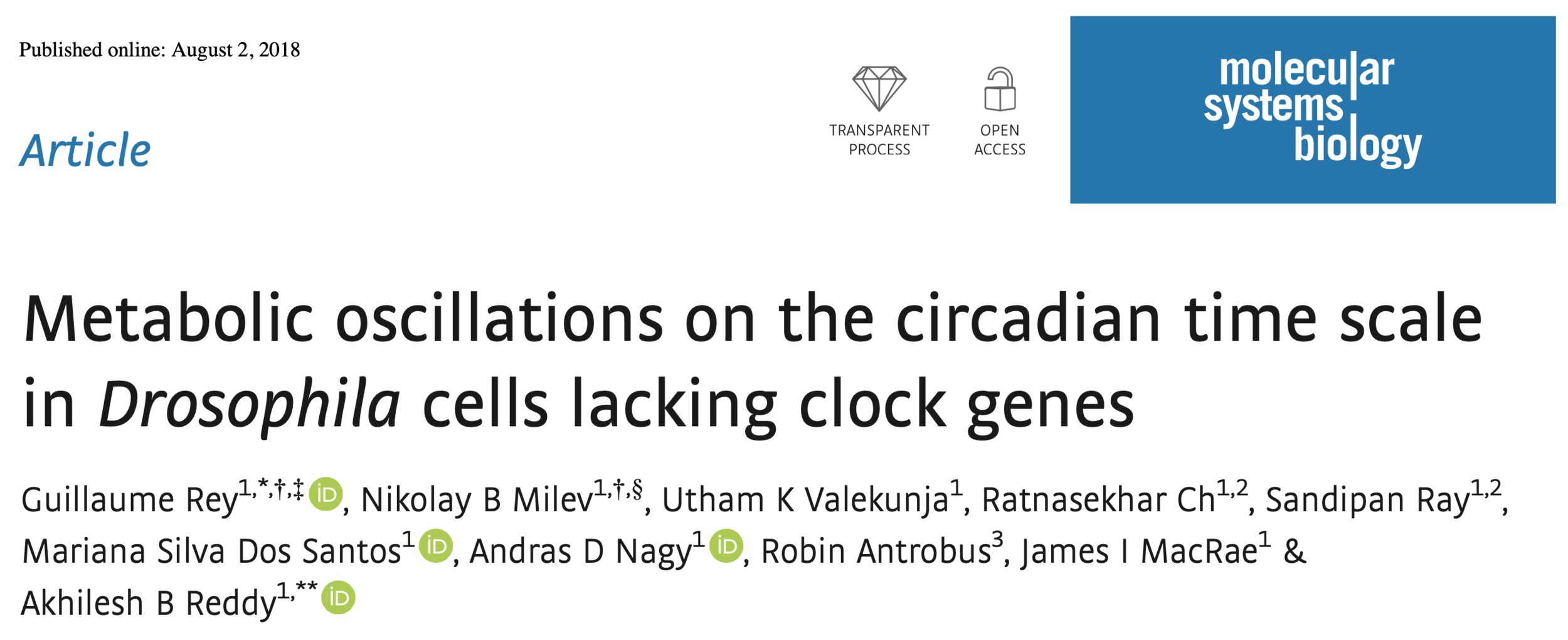Key Publications
THE First demonstration of non-transcriptional circadian oscillations in eukaryotic cells
We published two papers (O’Neill & Reddy Nature 2011; and O’Neill et al. Nature 2011) demonstrating the existence of circadian oscillations in the absence of transcription in two completely different model systems - human red blood cells and an alga called Ostreococcus tauri. This work is important because it highlights that circadian oscillations can occur in eukaryotes without genetic feedback loops – there is no transcription in red blood cells, or in algae held in the dark.
Circadian clocks in red blood cells
RNA synthesis (mRNA transcription) is not needed for 24 hour oscillations in the alga Ostreococcus tauri.
the pervasiveness of circadian redox oscillations in evolution
Our lab subsequently went on to demonstrate that redox oscillations in the form of rhythms in oxidation of the peroxiredoxin protein family are evolutionarily conserved in the three domains of life – bacteria, archaea and eukaryotes (Edgar et al. Nature 2012). This study has far reaching consequences for understanding how clocks arose, and the mechanisms by which they keep time. Before this study, it was thought that circadian clocks had evolved by convergent evolution in different species, whereas our work indicates that they may have instead evolved divergently, from a common origin.
gating of virus infection by the circadian clock
Since viruses are obligate intracellular pathogens, they must infect cells of an organism to reproduce. In this paper, we showed that the clockwork regulates the infection of two unrelated and common types of virus, herpesvirus and influenza A, such that time of day impacts on infectivity (Edgar et al. PNAS 2016). Importantly, we demonstrated that the clock gene Bmal1 is critical in restraining viral infection by quite diverse intracellular pathways that were targeted differentially by the two types of virus. Loss of Bmal1 leads to increased kinetics and overall levels of infection both in vivo and in cell culture, i.e. in the absence of the immune system. This work thus highlights a novel host factor (the circadian clock) that needs to be carefully considered in infectious diseases and in vaccination programmes in order to optimize therapy and prevention.
Glucose metabolism impacts on the clockwork
Metabolism and the clockwork are heavily intertwined. In this paper, we identified the pentose phosphate pathway (PPP) as an important clock regulator (Rey et al. Cell Metabolism 2016). The PPP is a key glucose-metabolising pathway regulates the central redox factor NADPH, and as such we suggest a mechanism by which NADPH controls the redox transcription factor NRF2 to direct 24-hour gene expression programmes. Importantly, we showed that the PPP regulates the clock in both invertebrates (fruit flies) and vertebrates (mammalian cells and tissue), indicating an evolutionarily conserved role for this pathway in clock regulation.
Daily oscillations in chromatin architecture
In this paper (Valekunja et al. PNAS 2013), we demonstrated that huge proportions of the liver's epigenome underwent circadian regulation, and that particular activatory chromatin marks (histone methylation) underwent this rhythmic change. We went on to identify that the histone methyltransferase MLL3, which is part of a highly conserved family of such enzymes, plays an important part in bringing about this change. Importantly, loss of MLL3's enzymatic activity severely perturbs cellular circadian oscillations, implicating rhythmic histone methylation as an important contributor to circadian transcription.
Circadian oscillations in “clockless” cells in the fruit fly
In this paper (Rey et al. Mol Sys Biol 2018), we asked whether there it is possible to generate circadian rhythms of transcripts, protein and metabolite levels in “clockless” Drosophila S2 cells. Fruit fly biologists had assumed that since S2 cells do not express the critical genes that drive 24-hour rhythms of behavior flies (per and tim), or their respective proteins (PER and TIM), they do not display circadian rhythms. However, no one had looked beyond the genetic circuit that PER and TIM are part of. This would mean that rhythms in thousands of other transcripts, proteins and metabolites could have been missed by earlier investigators, because they assumed that no rhythms would be present. We demonstrated that a large number of transcripts, proteins and metabolites undergo robust circadian oscillation. That is, in the absence of any external drivers (like light cycles or temperature rhythms). The overall emphasis of the rhythmic molecules was that they were principally focused on metabolism in its various forms, including glucose metabolism. These findings suggest that we still have an incomplete understanding of circadian rhythms in the fly, one of the most tractable organisms used to study circadian clocks. Moreover, it highlights metabolism as a key motif underlying circadian regulation in this system, echoing findings in other organisms, including mammals.
Circadian oscillations in “clockless” cells and tissues in mammals
The “clock gene” Bmal1 is believed to be critical for driving circadian rhythms of behavior and gene expression in mammals. Previous work showed that deletion of Bmal1 abolishes circadian behavioral rhythms, a feat that only this gene (or any other clock gene) could accomplish by its singular deletion. Bmal1 loss also abolishes molecular rhythms of the core genetic circuit that BMAL1 is part of - that involving the proteins PERIOD and CRYPTOCHROME. As such, it was concluded that there is no circadian clock in Bmal1-knockout cells and tissues. In Ray, Valekunja et al. Science 2020, we showed that this conclusion was, in fact, erroneous. That is, Bmal1-knockouts do have bona fide circadian rhythms of transcription and protein and phospho-protein expression of thousands of molecules. The pathways driving these novel circadian cycles do not involve any known “clock genes”, and may involve the ETS family of transcription factors, redox cycles and metabolic cycles in Bmal1-knockout cells. Our study highlights that we do not yet fully understand the underlying mechanisms that generate 24-hour rhythms in mammals, and poses some exciting possibilities for how such rhythms are generated in mammals and other species.











